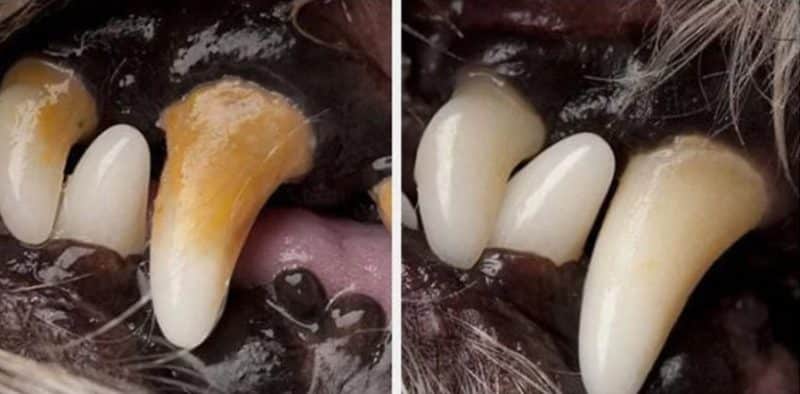NEWS
A Time for Paws: Dental Health in Your Pets

Before and After
Many years ago, when I graduated from veterinary school, we did not think much about dental disease in dogs and cats. We certainly did not study it in school. The issue only came up when someone’s pet got an abscessed tooth or had a tooth that was about to fall out. Given a situation like that, we would sedate the pet and remove the loose or abscessed tooth and maybe chip off any large pieces of tartar. In the last 30 years, we have learned a lot and we now realize the importance of dental health.
Dental disease is one of the most significant health problems in older dogs and cats. Not only does it cause a lot of pain from loose or abscessed teeth, but there are many illnesses that result from infection in the mouth. Problems begin as layers of bacteria start to grow on the teeth and form plaque. Over time, these layers of bacteria are mineralized and turned into a hard layer known as tartar. Under the tartar, bacteria continue to grow, and over time they destroy the bone and ligaments that help to hold the teeth firmly in place. These bacteria often produce sulfur compounds leading to bad breath. From the roots of the teeth, these bacteria gain access to the blood stream and shower the body with infection and seem to especially like to go to the heart valves, kidneys, and bladder.
We now understand that dental disease makes the immune system less effective at fighting disease. Older pets will spend a lot of energy fighting infection from the mouth. With this extra pressure on the immune system, older pets will often get heart disease and infections in the kidneys and bladder. Many times, we do not know this is going on until there has been a lot of permanent damage done to these body parts.
There are many products out there to help prevent tartar. Many work, and many do not. Please ask your veterinarian for some suggestions about which dental products work best. Brushing your pet’s teeth daily is the best way; however, it is tough to start brushing older dog’s teeth if they did not start young. Once the tartar has formed, there are no current products that will remove the mineralized mess. The only way to get rid of the tartar is a teeth cleaning. This is usually done on a sedated animal and requires an ultrasonic tooth scaler, as well as hand scaling and finally polishing the teeth, just as your dentist does for you.
So please watch your older pet’s mouths. If they seem uncomfortable eating or if you see a lot of tartar or if you smell bad breath, chances are high that they need a teeth cleaning and that they will feel very much better after getting their teeth cleaned. In younger pets, veterinary medicine recommends having regular teeth cleanings to prevent problems in the future, especially if you are not open to brushing your pet’s teeth daily.
Dick Hay
Dr. Dick Hay is a veterinarian at TotalBond Veterinary Hospital at Davidson and has lived in Davidson since 1989 with his wife Pam, a retired Davidson College biology professor. They raised two wonderful children in Davidson, Sarah and Ben. Dr. Hay is a Davidson College graduate from the Class of 1977 and received his MS and DVM degrees from the University of Georgia. He is active in the community, having served on several nonprofits boards, including many years with the Davidson Housing Coalition.


